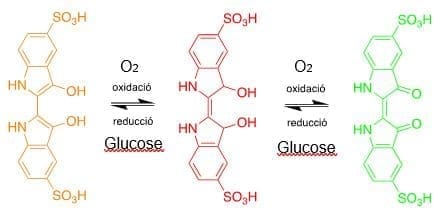Semáforo químico
Objetivo: Cambiar el color de una solución con sólo agitarla

-
Material de laboratorio
1 Erlenmeyer
3 Espátulas
1 botella de cristal con un vaso
-
Reactivos
Hidróxido sódico (NaOH)
Glucosa
Índigo carmín
Agua
-
Seguridad
¡¡¡No olvides los guantes, la bata de laboratorio y las gafas protectoras!!!
-
Preguntas
¿Qué tipo de reacción se está produciendo?
¿De dónde vienen todos los colores?
Procedimiento
- En un matraz Erlenmeyer, añade 100 mL de agua destilada.
- Pesa y añade 1,5 g de NaOH y remueve hasta que se disuelva.
- Pesa y añade 2 g de glucosa y remueve hasta que se disuelvan.
- Añade una pequeña cantidad de índigo carmín y mezcla bien.
- Espera a que la solución se vuelva amarilla, remuévela y observa lo que ocurre. El proceso puede durar unos minutos.
Explicación teórica
Los colores observados en este experimento proceden siempre del índigo carmín. Cuando se agita la mezcla, entra el oxígeno del aire y oxida el índigo carmín primero a su forma roja, y si seguimos agitando, podemos ver la forma verde. Cuando se deja de agitar, el oxígeno se consume, y el índigo carmín reacciona con la glucosa presente reduciéndolo a la forma roja, y finalmente vuelve a ser amarillo. El hidróxido de sodio se utiliza como base para facilitar todas estas reacciones redox.
Aquí tienes un esquema de las reacciones redox con los distintos colores del carmín índigo en medio básico:


Creemos un futuro más brillante
Únete a nuestro equipo para trabajar con investigadores de renombre, emprender proyectos innovadores y contribuir a avances científicos significativos.
Únete a nosotros!













